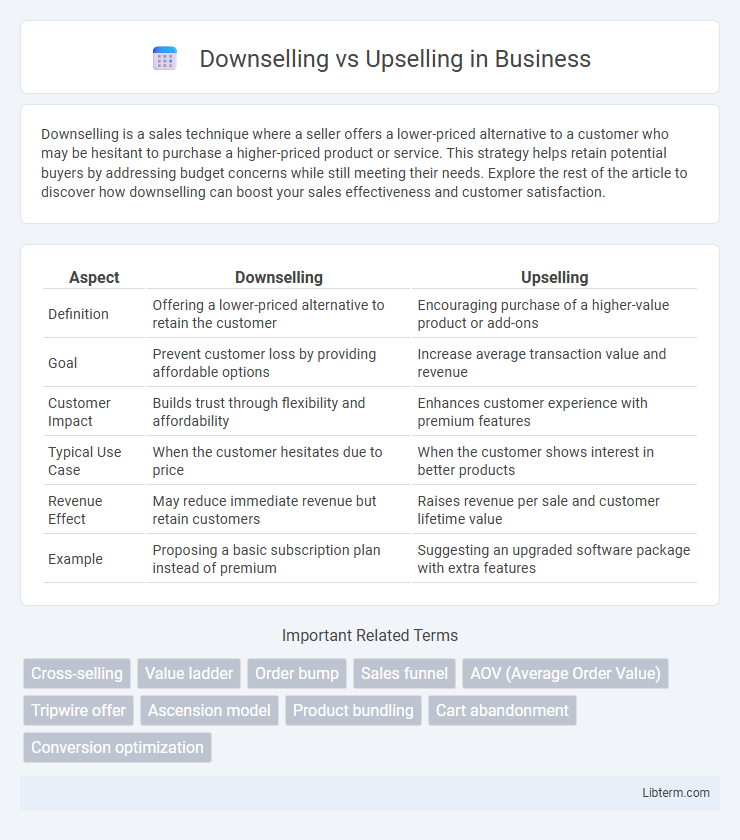Downselling is a sales technique where a seller offers a lower-priced alternative to a customer who may be hesitant to purchase a higher-priced product or service. This strategy helps retain potential buyers by addressing budget concerns while still meeting their needs. Explore the rest of the article to discover how downselling can boost your sales effectiveness and customer satisfaction.
Table of Comparison
| Aspect | Downselling | Upselling |
|---|---|---|
| Definition | Offering a lower-priced alternative to retain the customer | Encouraging purchase of a higher-value product or add-ons |
| Goal | Prevent customer loss by providing affordable options | Increase average transaction value and revenue |
| Customer Impact | Builds trust through flexibility and affordability | Enhances customer experience with premium features |
| Typical Use Case | When the customer hesitates due to price | When the customer shows interest in better products |
| Revenue Effect | May reduce immediate revenue but retain customers | Raises revenue per sale and customer lifetime value |
| Example | Proposing a basic subscription plan instead of premium | Suggesting an upgraded software package with extra features |
Introduction to Downselling and Upselling
Downselling and upselling are strategic sales techniques used to optimize customer purchases and enhance revenue. Upselling encourages customers to buy a more expensive or premium version of a product, while downselling offers a lower-priced alternative to prevent losing a sale. Understanding these approaches helps businesses tailor their offers to customer needs and improve overall sales performance.
What Is Upselling?
Upselling is a sales technique where a seller encourages the customer to purchase a more expensive item, upgrade, or add features to increase the overall sale value. This strategy aims to enhance customer satisfaction by providing better products or services that meet their needs more effectively while boosting business revenue. Effective upselling relies on understanding customer preferences and presenting relevant, value-driven options that align with their goals.
What Is Downselling?
Downselling is a sales technique where a seller offers a lower-priced alternative to a customer who may be hesitant to purchase a higher-priced product or service. This strategy helps retain potential buyers by providing more affordable options that still meet their needs, increasing customer satisfaction and reducing lost sales. Effective downselling can improve overall conversion rates by capturing sales opportunities that might otherwise be missed due to price sensitivity.
Key Differences: Downselling vs Upselling
Downselling involves offering a lower-priced alternative to retain a customer who may be hesitant to buy, whereas upselling encourages the purchase of a higher-value product or add-ons to increase the sale amount. The key difference lies in the pricing strategy: downselling aims to prevent customer loss by reducing price, while upselling seeks to maximize revenue by enhancing the product or service purchased. Both techniques require understanding customer needs and behavior to effectively influence buying decisions.
Benefits of Upselling for Businesses
Upselling increases average transaction value by encouraging customers to purchase higher-end products or add-ons, boosting overall revenue. It enhances customer satisfaction by offering tailored solutions that better meet their needs, leading to stronger brand loyalty. Implementing effective upselling strategies improves profit margins and supports long-term business growth through repeat purchases and higher lifetime customer value.
Advantages of Downselling Strategies
Downselling strategies enhance customer retention by offering more affordable options that better match buyers' budgets and needs, reducing the risk of cart abandonment. They build trust and foster long-term relationships through personalized, value-driven offers that prevent customer frustration from high-priced options. Implementing downselling can increase overall sales volume by capturing price-sensitive segments and turning hesitant prospects into repeat customers.
When to Use Upselling Techniques
Upselling techniques are most effective when customers show clear interest in higher-value products or enhanced features, as it capitalizes on their existing purchase intent by offering superior options. Businesses should implement upselling during the decision-making phase, such as when a customer adds items to their cart or requests product information, to maximize conversion rates and increase average order value. Employing personalized recommendations based on customer behavior and preferences further enhances upselling success by aligning offers with individual needs.
Scenarios Favoring Downselling
Downselling is favored in scenarios where customers hesitate at higher-priced offerings, enabling businesses to retain sales by presenting more affordable alternatives that meet essential needs. This strategy minimizes cart abandonment and builds customer trust by aligning offerings with customers' budget constraints and preferences. Implementing downsell tactics effectively boosts revenue through volume while maintaining customer satisfaction and loyalty.
Common Mistakes in Downselling and Upselling
Common mistakes in upselling include pushing irrelevant or overpriced products, which can alienate customers and reduce trust. In downselling, errors often involve suggesting lower-value alternatives too quickly, potentially undervaluing the customer's needs and damaging perceived product quality. Both strategies suffer when sales reps fail to listen to customer intent, leading to mismatched offers that reduce conversion rates and customer satisfaction.
Best Practices for Balancing Both Approaches
Effective balancing of downselling and upselling hinges on understanding customer needs and purchasing behavior to provide tailored recommendations that maximize value without overselling. Implementing data-driven segmentation allows businesses to identify when to introduce lower-priced alternatives or premium add-ons, enhancing customer satisfaction and increasing average transaction value. Training sales teams on empathetic communication and product knowledge ensures seamless transitions between offers, optimizing revenue while maintaining trust and loyalty.
Downselling Infographic

 libterm.com
libterm.com